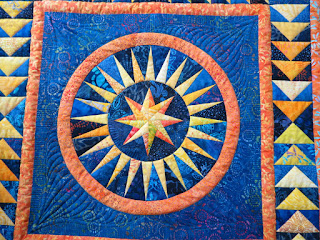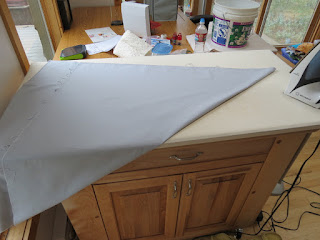Hi all -
Sorry it's been so long since my last post. I keep hoping to post weekly, but I'm not accomplishing much right now so I keep putting it off. I'll try to be better!
First, the good news. I got an email yesterday letting me know that
Tea for Two won a ribbon at Houston! I'm stunned and thrilled!! I won't know exactly what I won until awards night, but it doesn't really matter since I will cherish any ribbon that they decide to give to me!! And my friend Janet Stone won a ribbon for one quilt and one of the big prizes for her other quilt. And my friend Peggy Kragnes won a ribbon for her quilt. I'm hoping that other friends have won, too, but that's all I've heard about so far. It's so exciting being a part of this impressively talented group and I can't wait to see how everybody did! I'll be attending the awards ceremony for the first time, so Janet warned me that I'll have to find some nicer clothes to wear. She knows my standard wear is shorts and a T-shirt, so she didn't want me to be embarrassed when I get my picture taken on stage. Thank you!! I'll share the whole experience with you after the show in early November.
Now on to my current projects. My latest accomplishment was finishing the background quilting on
Bird Song, the little quilt I started in my twilling class at the Kansas City Regional Quilt Festival this summer. As a reminder, here is a picture of the finished quilt;
If you want more information, you can see my previous post about this quilt
here.
The last time I showed you this piece, I had echo quilted around the twilling in the middle, but had left the rest of the center unquilted. I had also quilted the borders and added the binding so I could think about how to finish the center. The first thing I was worried about in the center was that the echo quilting was 1/4" from the edges of the twilling. I had to do this because the twilling stitches are very thick so I couldn't run my darning foot over them. But the bird and tree branch were just too big to leave without more quilting so I had to come up with a way to quilt closer to the stitching.
I started looking at the different FMQ feet available for the Bernina, but none of them seemed like they would work for this. Then it dawned on me that I might be able to use my regular FMQ foot and move the needle over to the right to get closer the the edge of the foot. But as I thought about this, I didn't think that it would work in the tight areas and I really wanted to get closer to the stitching that this would allow. I wanted my stitching to run right up against the outside edges of the twilling. So back to the drawing board.
Then it dawned on me that I didn't need to use a free-motion foot for this. I have several regular feed that have space on the bottom for things like couching. So I looked through my feet and started with the #12 foot. This is a metal foot with a really big arch on the bottom that works great with couching and piping.
I put it on and gave it a try and it worked really well except that I could see where I was going. I had to stop every few stitches and raise the presser foot to make sure I was staying on course.
So I decided to try my #23 foot. This foot has a cut-out on the bottom, but it's not nearly as deep as the arch in the #12 foot. But the bottom of this foot is clear so I could see exactly where I was going. Here's how it looked on the machine:
I was very pleased with how this foot worked, but I was a little uncomfortable with how it smashed the twilling a bit,especially in places where the stitching intersected with other stitching.
Then I made a trip to my Bernina shop and picked up some other feet that I'd been wanting, including the #44C free-motion echoing foot. I'm really bad at echo quilting so wanted this foot to see if it would help me improve. After I got home, I realized that this was probably also the perfect foot for going around my twilling. The bottom of this foot is a clear circle with raised edges. The raised edges would allow the foot to float over the twilling. I tried it and it was perfect:
It really does pay to collect feet! It's hard to see the stitching next to the twilling, but here's a close-up to hopefully give you an idea:
Finally, I had to do some background quilting to tack everything down and make the stitching stand out. I've been wanting to try Nemeshing, a really cool background fill invented by Bethanne Nemesh. If interested, you can see her book
here. This fill is made up of sprigs of classic and fanciful feathers, optionally surrounded by a tighter background fill. It's funny, but what attracted me most to her Nemeshing was the way she did her pebbles, where she periodically threw in some much larger pebbles. I'd always done my pebbles with varying sizes, but my variations were smaller -- just enough to make them more organic. But throwing in those larger pebbles really gives them some pop. And having the feathers really speeds up the quilting while adding that extra interest. My background was kind of oddly shaped so I had trouble fitting the feathers in nicely, but I still really like how it turned out:
And I was really happy that this evening's lighting was perfect to see the quilting because it's really hard to see with the white thread on the white background! Just to be complete, here's a picture of the back with the hanging sleeve:
I'll add the label later. The software the I used to use for creating labels on my old computer (Greeting Card Factory) was bought out by Hallmark and I just recently bought the latest version to use on my newer computer. I played with it a little bit but don't like the new interface. It looks like you can't zoom in to see your images at their actual size so it's going to be frustrating getting things sized appropriately, but I'll persist and figure something out soon so I can get my latest quilts labelled. It's really nice to have this one done!
I also spent a bit of time trying to baste my sister's wedding quilt so I can start the quilting. I just can't seem to force myself to do the pin-basting even though I've done this many times on all my other quilts. I guess I'm just getting too old to crawl around on the floor! So I thought I should baste it using water-soluable thread on my HQ16. Those of you who don't know me might not know that I have this machine. I bought it over 10 years ago and back then they just dumped the pieces on your doorstep and you had to put it together. Anyway, long story short, my machine is not easy to use because the table is pretty bad and I haven't had the time to spend figuring out how to fix everything up right. Sounds silly, but I'll really need to dedicate some time to get things working better and I'm not ready to do that yet. So, I decided to get the quilt that's been sitting on that machine for a very long time quilted to the point were I could take it off the frame, then load my sister's quilt and get it basted. I finished the quilting and unloaded the quilt. Then ran into another snag. Even though I have my HQ16 set up with the queen-sized table, bars and leaders, it turns out that my quilt is an over-sized queen so it didn't fit on the leaders. Guess it pays to measure! But it didn't dawn on me that this would be a problem. And I don't have room to add the last piece of the table to make it king-sized. Back to the drawing board..... My next thought was to load the quilt anyway and just baste the middle, either pin-basting or reloading to get the sides done. That was another bad idea. Even though I only had 8-10 inches of extra backing on each side of the leader, the extra fabric kept me from being able to roll the back on the bars evenly, so that just wasn't going to work. My current plan is to call the local Bernina shop and see if they are ready to start renting time on their new longarm yet and just take it there to do the basting. Wish me luck!!
Finally, when going through these times of low motivation, I tend to watch a lot of Craftsy classes. I own and watch a lot of classes and often only get small ideas from each, but I still find them enjoyable. However, I came across a new class that really kept me riveted and has me wanting to try a bunch of new techniques. The class is called
Stitch Savvy by Lynda Faires. OMG! The things she has figured out how to do with a sewing machine! I haven't tried any of the techniques yet, but I did start on my stitch dictionary:
These are the stitches from just one folder on my new machine. I have MANY more stitches to go, not to mention being able to mirror image and combine them into other stitches. Amazing! I happened to sign up for her Artist's Bag class in Houston before even trying this class, so I'm really looking forward to that now!
Well, that pretty much covers what I've been doing lately. I'll leave you with just one more picture:
Does this seem like a bad idea to any of the rest of you? Luckily in this case the iron was unplugged. Yesterday I caught her laying just a couple of inches away from the hot iron. I'm not sure how to teach the kitties to stay off of the pressing table. I might have to start putting the Scat Mat on the table when I'm not using it. We'll see if this gets to be a bigger problem......
Nancy













































